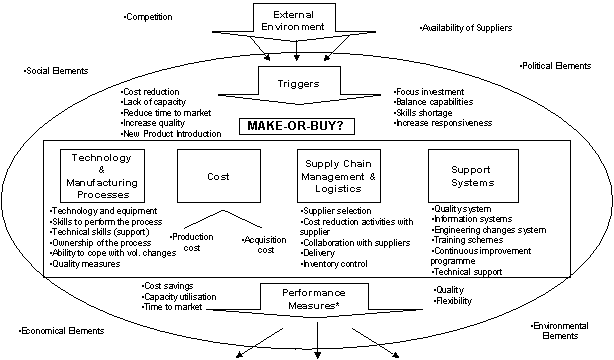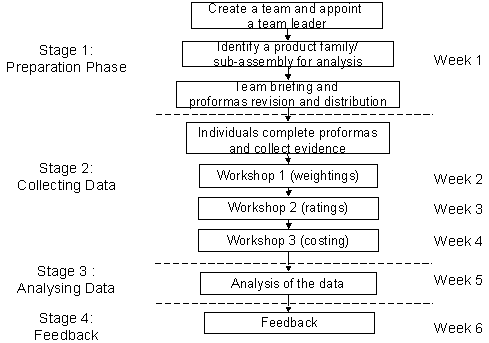Industrial Make-or-Buy Decisions
Background
The make-or-buy question represents a fundamental dilemma faced by many companies. Today's global competition forces manufacturing companies to re-evaluate their existing processes, technologies, manufactured parts and services in order to focus on strategic activities. However, companies have finite resources and may not be able to afford to have all activities in-house.
This has resulted in an increasing awareness of the importance of the make-or-buy decision, the dilemma organisations face when deciding between keeping technologies/processes in-house or purchasing them from an outside supplier The ability to make such decisions in a structured and rational manner is likely to improve a company's overall performance.
Aim
The aim of this research is to develop a decision-making methodology that can provide managers in manufacturing industry with a way of addressing the make-or-buy decision more effectively and with greater consistency and repeatability than existing methods.
Objectives and Results
This project has been completed and the outcome of the project has been developed into a workbook, click here for more information.
The original objectives of the project and their achievements are outlined below.
- Develop and test a make-or-buy decision making methodology
- Achieved - a make-or-buy decision-making methodology has been developed and tested in eight companies. The methodology helps managers in manufacturing undertake make-or-buy decisions in a structured and consistent manner.
- Develop a theoretical framework encapsulating the factors which affect the make-or-buy decision
- Achieved - a make-or-buy framework that captures relevant factors to be considered in make-or-buy decision has been developed and tested using input from theory and practice.
- Understand better the challenges and barriers that suppliers and assemblers face when deciding whether or not to outsource a component or process
- Achieved &endash; the make-or-buy framework captures relevant factors that assist companies understanding the various challenges and implications of outsourcing.
- Produce case studies illustrating the use of the methodology in collaborating companies.
- Achieved- the process has been tested in eight in-company cases. The cases are used in a make-or-buy workbook to illustrate the use of the methodology and lessons learned.
Duration of the project
This project started in January 1998 and was completed in January 2001.
Sponsors/Collaborators
The researchers wish to express their thanks to all collaborating companies:
- Rolls Royce
- Kenwood
- Philips Paging
- Biochrom
- Peter Brotherhood
- Harris Broadcast
- 3COM, Federal Mogul
- General Domestic Appliances
- Anritsu
Researchers
- Laura Canez
- Ken Platts
- David Probert
The Make-or-Buy Framework
The framework depicted in Figure 1 provides a graphical representation of why operational make-or-buy decisions are made and shows relevant dimensions to be studied in approaching such decisions. In contrast with existing frameworks, this provides a holistic view of make-or-buy and captures relevant factors in a structured manner. Additionally, it takes a first step towards providing performance measures for the assessment of the business benefits delivered by individual make-or-buy decisions.
The external environment, on which the company has little or no influence, usually activates triggers for the make-or-buy analysis. For instance, increased price competition in the market place usually forces companies to reduce costs. The triggers are the reason(s) for undertaking the make-or-buy review and can be easily identified by asking why the decision is being made. In this example, the cost reduction trigger raises the make-or-buy question. The framework clusters factors relevant to make-or-buy into four areas: technology and manufacturing processes; cost; supply chain management and logistics; and support systems. The performance measures are closely linked to the triggers. They aim at providing some criteria to evaluate the extent to which the targets suggested by the triggers are achieved. For instance, if the trigger is cost reduction, cost saving should be the key performance measure. However, other measures such as flexibility and quality should not be neglected. Finally, the arrows coming out from the performance measures to the external environment show that make-or-buy is not a static issue. The performance measures for these decisions feed back into the external environment and possibly activate other triggers that raise again the make-or-buy question.
Fig 1 Make-or-Buy framework

The framework is described in more detail together with a make/buy process in a workbook which is available for sale commercially. Click here for more information.
The Make-or-Buy Process
The framework presented above captures relevant factors to be considered in specific manufacturing make-or-buy decisions. However, these factors need to be traded-off in order to reach a decision. In order to do so, a decision making process which compares in-house with supplier capabilities using of Multi-Attribute Decision-Making (MADM) was developed. The process consists of four stages as summarised next (see Figure).
Stage 1 refers to the preparations phase, which entails creating a multi-disciplinary team, selecting the part, assembly or family of parts for analysis and briefing the team.
Stage 2 is concerned with data collection. Here, three workshops are organised in order to collect the information required to carry out the analysis. Workshop 1 consists of prioritising the make-or-buy areas and factors. Using the rankings, weightings are generated using the centroid method (Kmietowicz and Pearman, 1984; Olson and Dorai, 1992). The weightings generated should reflect the relative importance of each area and its sub-factors to the decision under consideration. Workshop 2 is concerned with the assessment of internal and external capabilities using a set of proformas, which cover the four relevant areas. These proformas use a five-point scale for the assessment. Workshop 3 consists of capturing the costs incurred in both producing internally and externally. These costs are then compared and rated on a five-point scale.
Stage 3 consists of data analysis using a spreadsheet which provides the following:
- Final scores for in-house and for the supplier. The highest score indicates the best option.
- Weighted gaps for each factor area, highlighting the strengths and weaknesses of this option.
- A sensitivity analysis which tests the robustness of the final outcome.
Stage 4 consists of feeding back the results to the team.
Fig Make-or-buy Process

The process has been demonstrated to be feasible, usable and useful during its application in eight in-company case studies. It proved successful in assisting manufacturing managers to address make-or-buy decisions in a holistic and structured manner and in helping them generate clear action.
To purchase the workbook, please visit here.









